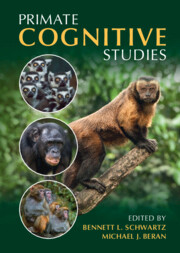139 results
98 Cognitive Outcomes Following Bilateral Focused Ultrasound Thalamotomy for Tremor
-
- Journal:
- Journal of the International Neuropsychological Society / Volume 29 / Issue s1 / November 2023
- Published online by Cambridge University Press:
- 21 December 2023, pp. 197-198
-
- Article
-
- You have access
- Export citation
TOWARDS A RADIOCARBON-BASED CHRONOLOGY OF URBAN NORTHERN MESOPOTAMIA IN THE EARLY TO MID-SECOND MILLENNIUM BC: INITIAL RESULTS FROM KURD QABURSTAN
-
- Journal:
- Radiocarbon / Volume 65 / Issue 3 / June 2023
- Published online by Cambridge University Press:
- 09 June 2023, pp. 755-770
- Print publication:
- June 2023
-
- Article
-
- You have access
- Open access
- HTML
- Export citation
Contributors
-
- Book:
- Primate Cognitive Studies
- Published online:
- 28 July 2022
- Print publication:
- 11 August 2022, pp xii-xiv
-
- Chapter
- Export citation
Copyright page
-
- Book:
- Primate Cognitive Studies
- Published online:
- 28 July 2022
- Print publication:
- 11 August 2022, pp iv-iv
-
- Chapter
- Export citation
Contents
-
- Book:
- Primate Cognitive Studies
- Published online:
- 28 July 2022
- Print publication:
- 11 August 2022, pp v-vii
-
- Chapter
- Export citation
Acknowledgments
-
- Book:
- Primate Cognitive Studies
- Published online:
- 28 July 2022
- Print publication:
- 11 August 2022, pp xv-xvi
-
- Chapter
- Export citation
Figures
-
- Book:
- Primate Cognitive Studies
- Published online:
- 28 July 2022
- Print publication:
- 11 August 2022, pp viii-x
-
- Chapter
- Export citation
Index
-
- Book:
- Primate Cognitive Studies
- Published online:
- 28 July 2022
- Print publication:
- 11 August 2022, pp 674-694
-
- Chapter
- Export citation
Tables
-
- Book:
- Primate Cognitive Studies
- Published online:
- 28 July 2022
- Print publication:
- 11 August 2022, pp xi-xi
-
- Chapter
- Export citation
1 - The Purpose of Primate Cognitive Studies
-
-
- Book:
- Primate Cognitive Studies
- Published online:
- 28 July 2022
- Print publication:
- 11 August 2022, pp 1-11
-
- Chapter
- Export citation

Primate Cognitive Studies
-
- Published online:
- 28 July 2022
- Print publication:
- 11 August 2022
Seedbank management through an integration of harvest-time and postharvest tactics for Italian ryegrass (Lolium perenne ssp. multiflorum) in wheat
-
- Journal:
- Weed Technology / Volume 36 / Issue 2 / April 2022
- Published online by Cambridge University Press:
- 18 April 2022, pp. 187-196
-
- Article
-
- You have access
- Open access
- HTML
- Export citation
Identification and description of patients with multisystem inflammatory syndrome in adults associated with SARS-CoV-2 infection using the Premier Healthcare Database
-
- Journal:
- Epidemiology & Infection / Volume 150 / 2022
- Published online by Cambridge University Press:
- 17 January 2022, e26
-
- Article
-
- You have access
- Open access
- HTML
- Export citation
Seed-shattering phenology at soybean harvest of economically important weeds in multiple regions of the United States. Part 3: Drivers of seed shatter
-
- Journal:
- Weed Science / Volume 70 / Issue 1 / January 2022
- Published online by Cambridge University Press:
- 15 November 2021, pp. 79-86
-
- Article
-
- You have access
- Open access
- HTML
- Export citation
Holocene glacier history of northeastern Cordillera Darwin, southernmost South America (55°S)
-
- Journal:
- Quaternary Research / Volume 105 / January 2022
- Published online by Cambridge University Press:
- 16 August 2021, pp. 166-181
-
- Article
- Export citation
Rehearsing Revolutions: The Labor Drama Experiment and Radical Activism in the Early Twentieth Century By Mary McAvoy. Iowa City: University of Iowa Press, 2019; pp. x + 260, 6 illustrations. $90 paper, $90 e-book.
-
- Journal:
- Theatre Survey / Volume 62 / Issue 3 / September 2021
- Published online by Cambridge University Press:
- 03 August 2021, pp. 376-378
- Print publication:
- September 2021
-
- Article
- Export citation
A comparative cross-sectional assessment of statistical knowledge of faculty across five health science disciplines
-
- Journal:
- Journal of Clinical and Translational Science / Volume 5 / Issue 1 / 2021
- Published online by Cambridge University Press:
- 14 July 2021, e153
-
- Article
-
- You have access
- Open access
- HTML
- Export citation
A hybrid model connecting regulatory interactions with stem cell divisions in the root
-
- Journal:
- Quantitative Plant Biology / Volume 2 / 2021
- Published online by Cambridge University Press:
- 12 April 2021, e2
-
- Article
-
- You have access
- Open access
- HTML
- Export citation
Chapter 16 - The Cal-DSH Diversion Guidelines
- from Part II - Solutions
-
-
- Book:
- Decriminalizing Mental Illness
- Published online:
- 19 October 2021
- Print publication:
- 07 January 2021, pp 155-173
-
- Chapter
- Export citation
Seed-shattering phenology at soybean harvest of economically important weeds in multiple regions of the United States. Part 1: Broadleaf species
-
- Journal:
- Weed Science / Volume 69 / Issue 1 / January 2021
- Published online by Cambridge University Press:
- 04 November 2020, pp. 95-103
-
- Article
-
- You have access
- Open access
- HTML
- Export citation



